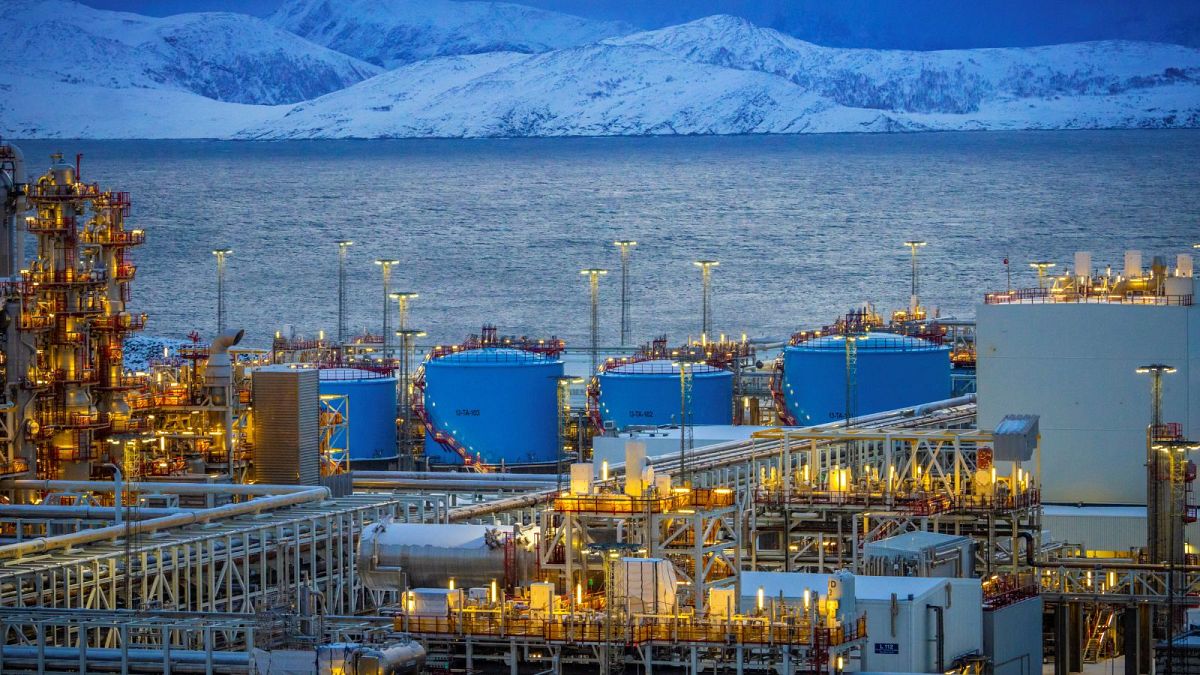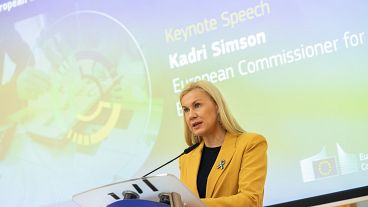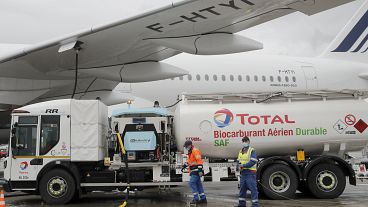A huge growth in renewables, as well as gas from Norway and the US, is helping to make up for the dramatic drop in Russian energy.
On the day that Russia invaded Ukraine, EU officials met to agree on energy sanctions.
From the very start of the war on 24 February 2022, the bloc understood that weaning itself off Russian fossil fuels was a key economic weapon.
“Over the past year, we have shown that by acting in unity we can face off the Russian blackmail with regards to energy,” a European Commission spokesperson tells Euronews Green.
As the war in Ukraine has continued, the EU has ramped up its sanctions and sought alternative ways to meet Europeans’ energy needs.
Imports of coal and other solid fossil fuels were first prohibited on 8 April last year. A ban on crude oil and refined petroleum products followed, with limited exceptions, on 3 June.
As a response to these waves of sanctions, Russia has cut 80 per cent of gas supplies to the EU.
So how exactly has the energy used by the EU changed since the invasion? And what is making up the shortfall?
Eurostat, the EU’s official statistical office, has recorded the dramatic shift in the amount of energy the EU has imported from Russia.
In 2020, Russia supplied 24.4 per cent of the EU’s gross available energy while domestic production satisfied only 41.7 per cent of its needs.
That means the EU imported 57.5 per cent of the energy it consumed that year.
The share of Russian energy in overall EU imports was a massive 42.6 per cent - more than any other country.
Sharp decline in natural gas imports from Russia
The most striking change in EU energy imports since the Russia-Ukraine war began has been seen in ‘natural’ (fossil) gas.
In 2021, the EU imported 83 per cent of its natural gas. Before the war, EU natural gas imports from Russia made up almost 50 per cent of the total.
This fell significantly in 2022, down to 12 per cent in October.
As the chart above shows, the shares of natural gas imports from Russia and other non-EU countries were very similar in 2019, 2020, and the first half of 2021. In December 2021, Russia’s share was still more than 41 per cent.
However, following the full-scale invasion of Ukraine, the EU’s efforts to diversify its sources of Russian gas stepped up dramatically.
LNG imports from the US more than doubled
Between January and November 2022, imports of pipeline gas and liquified natural gas (LNG) from Russia made up just less than a quarter of all EU gas imports.
Another quarter came from Norway and 11.6 per cent was shipped in from Algeria. LNG imports excluding Russia constituted 25.7 per cent. This fuel was mainly supplied by the United States, Qatar, and Nigeria.
The significant decline in Russia’s share has mainly been compensated for by a dramatic increase in imports of LNG, particularly from the US. Between January and November 2022, LNG imports from America were more than twice the volume reached in the whole of 2021.
EU imports of all kinds of energy from Russia gradually fell across each quarter of 2022.
While 275.6 million tonnes of energy products were imported from Russia in 2021, only 156.2 million tonnes were imported in the first three quarters of 2022.
Considering the declining trend in every quarter, energy imports from Russia will almost definitely show a significant decrease when the annual data is released in full.
Russia’s share of trade also declines
While energy prices may vary year by year, the decline in Russia’s share of trade in EU energy imports is also striking.
Russia’s average shares in the EU’s imports from outside its borders of natural gas, petroleum oils, and coal decreased significantly between the second and third quarters of 2017-2021 compared to the same seasons in 2022.
These slices of the fossil fuel trade fell by 15.6, 9.2, and 13 percentage points respectively.
Taking into account seasonal swings, Russia’s share in EU energy imports was stable in the three years leading up to the first quarter of 2022 - before the war began. It hovered between 26 and 27 per cent.
But this proportion fell sharply between the first and second quarters of 2022 as the bloc began to wean itself off Russian energy. The downward trend resulted in a share of 15.1 per cent in the third quarter.
That reflects a decline of more than 10 percentage points in Russia’s share of EU energy imports between the first and third quarters of 2022, from 25.5 per cent to 15.1 per cent.
Which countries have replaced Russian energy?
The combined share of imports from the US and UK was 15.1 per cent in the last quarter of 2021. This rose to 19.9 per cent in the third quarter of 2022.
That suggests that almost half of the fall in the Russian share is being picked up by the US and UK.
Looking at natural gas and petrol (petroleum oils) separately, the charts below show the countries that have replaced Moscow’s share in trade.
Russia was the largest supplier of natural gas to the EU with a share of 39.3 per cent in 2021, followed by Norway (24.2 per cent) and Algeria (8.2 per cent).
Compared to 2021, Russia’s share of imported natural gas dropped by 24.3 percentage points to stand at only 15 per cent in the third quarter of 2022.
Shares from the United States (+8.2 percentage points), Norway (+6.6 percentage points), and the United Kingdom (+6.1 percentage points) all increased.
Russia was also the largest provider of petroleum oils in 2021. Its share was 14.4 per cent in the third quarter of 2022, reflecting a decrease of 10.4 percentage points compared to 2021. The shares of Saudi Arabia (+4.0 percentage points) and the United States (+3.0 percentage points) increased.
EU welcomes the decline in dependency on Russia
The European Commission says it is content with the progress made so far.
“The measures introduced last year have proved effective in reducing our dependency on Russian fossil fuel imports and guaranteeing the EU’s security of supply, allowing us to safely bridge this winter,” a Commission spokesperson told Euronews Green.
A significant growth in renewables deployment has also proved to be a lifeline, with 50GW of additional capacity coming online. That’s enough to power around 750,000 homes.
And while the energy coming from Russia has significantly decreased, the EU is determined to keep diversifying its energy portfolio.
What impact are energy sanctions having on Russia?
A recent report found that Russia is losing more than €160 million per day due to the combined impact of the EU's far-reaching oil embargo and the G7's price cap.
The Centre for Research on Energy and Clean Air (CREA) report indicates that the sanctions have a severe impact on the Russian economy. The sale of all fossil fuels represented around 40 per cent of Russia’s federal budget, earning the country €1 billion per day in March 2022.
By early February 2023, that figure dropped to €640 million per day - and is set to fall even further with the EU phasing out all seaborne imports of refined petroleum products on 5 February.
But more action is needed to tackle Russia’s fossil fuel earnings, which it uses to bankroll its war in Ukraine.
“The energy war waged by Putin against Europe and the world is not over yet and we need to continue our work on supplies diversification, renewables deployment, energy demand reduction and storage,” the Commission spokesperson said.



